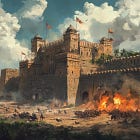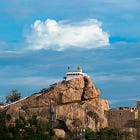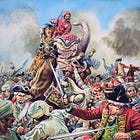Greek Abhishekam, 1800s Cola Wars, Pasta Playlists - Monday Cup Of Links #97
Tahawwur Rana explained
Happy Monday!
Happy Varshapirappu/Vishu/Baisakhi/Songkran! It’s a new solar year, and it’s time to check in on your Gregorian new year resolutions and course-correct.
Spring is in full swing. The sourgrass is wilting, little green strawberries are showing up, and there’s not a cloud in the sky. It’s perfect conditions to write outdoors. I particularly like being able to stare into space instead of a screen, I feel it aids focus and creativity.
Onto our links!
Tahawwur Rana’s extradition and revisiting 26/11
In great news for India, terrorist Tahawwur Rana, the one responsive for the recce of Mumbai, based on which the 26/11 terror attacks happened, has been extradited from the US to India, where he will face justice.
While I was a sociopolitically aware adult when it happened, and I followed it on TV as it unfolded I realized I don’t have the whole picture of what happened. I did know all the missteps of the government during and after the attack happened. But… learning that David Headley was working with the DEA was news to me.
17 years on, I tried to piece together the narrative as I tried to explain it all to my husband. I found this discussion with Shiv Aroor most useful on reconciling the story as it happened with the larger narrative.
This one goes into the missteps that had it be so bad:
This explainer goes into the plotting of the attack and the background of the terrorists.
I think I still need to put the pieces together for myself into a coherent narrative.
Colorful, perfumed Greek and Roman statues
When we see Greek statues and sculptures, we assume their aesthetic was of pure white marble, and that’s the aesthetic that got replicated during the Renaissance and later.
But we’ve known for some time now that the sculptures were painted brightly and were also adorned with clothes.
This new piece tells us that these statues weren’t just painted and dressed, but also anointed with perfumes and oils. They rely on Greek texts describing how the statues were perfumed. They used beeswax, olive oils, roses and sodium carbonate for their deities.
Which makes perfect sense - even today, Hindu deities are bathed in various items like milk and oils, and then rinsed and dressed up in silks and jewelry. The tone of this article makes me smile though:
Perfumes were not only used to beautify the sculptures but also served a ritual function. In ancient Greece and Rome, the gods were honored with exotic fragrances and scented oils. {…..}
The use of perfumes and fragrances in ancient art was not merely decorative; it was part of a symbolic and religious language that endowed sculptures with a more tangible presence. This sensory dimension could explain why some religious images were so venerated and why their preservation and embellishment were considered acts of devotion.
There’s so much surprise at this practice, and further along in the article, they are surprised at flowers being used to venerate the deities.
I think more Hindus should get into being ancient history researchers - we follow a primary religion that connects us with the world around us, and follow practices straight from the Bronze age on a daily basis. That’d make us more suited to understand ancient cultures than others who might not have this connection.
Soda wars of the 19th Century
In the late 19th century, people discovered how to carbonate water. People liked the spectacle of fizzy water, mixed with a variety of syrups, fruit juices, essential oils, creams. Soon, the focus became the soda machine!
As the article says:
Thus begun, essentially, a soda fountain arms race. Inventors sought the perfect combo—the most efficient technology in the most ostentatious package. The “Monitor Crystal Spa,” by William Gee, had a spinning carousel for syrups, and was topped by a tasteful nude statue. J.G. Low’s massive three-sided fountain featured a tile mosaic depicting a kind of soda origin myth, in which dancing angels crushed fruits into a “Fountain of Thirst.” One well-worn story had an old woman mistaking a soda fountain for a war monument, and the many sparkling water types it advertised—Saratoga, Deep Rock, Washington—for battles.
The pinnacle of this soda craze:
Perhaps the height of soda opulence came with the nation’s Centennial Exposition, held in Philadelphia in 1876. In a rare show of collaboration, rival fountaineers James Tufts and Charles Lippincott purchased the dispensary rights for the entire show, and collaborated on about a dozen massive fountains: the quaint Hartford, the intimidating Saxon. Outside one exhibit hall, in the hot sun, stood the largest of all—a three-story behemoth festooned with ferns, chandeliers, elaborate murals, and seventy-six syrup spigots.
Why… why do we stick with the boring soda fountain dispensing only a few sickly-sweet syrups? We must RETVRN.
The Game Of Thrones-esque Scramble for Trichy
Last Wednesday, I went into the next chapter of Vikram Sampath’s book on Tipu Sultan. This chapter goes into how the corrupt minsters of Mysore went into decline, allowing Haider Ali to rise. And this decline happens through a Game Of Thrones style struggle for the impregnable Rock Fort of Trichy. Constantly changing alliances, bribes, backstabbing, obscene sums of money, blockades, sieges… and all of this on the backs of brave, long-suffering soldiers.
The whole era of the Carnatic Wars is WILD.
Here’s how it all starts:
And then this is when the Europeans get involved:
But as enjoyable as all of this has been, I’m glad to be done with this and move on to the actual events involving Haider Ali and Tipu Sultan.
Pasta Playlists
Barilla, the world’s largest pasta company, has playlists to accompany your cooking each type of pasta. Each playlist is timed so you turn it on when you start cooking the specific kind of pasta, pasta and when it ends, the pasta is cooked al dente.
Artifact: 19th century Japanese depiction of an American
Inspired by Ghibli art, I looked into historical Japanese art, and found this painting of an American on horseback, at the Met Museum, by Utagawa Yoshitora.
Apparently there’s a whole genre of woodblock prints of foreigners called Yokohama-e - Scenes in the port city of Yokohama. Utagawa Yoshitora was a big exponent of this genre, and published a lot of books with these prints.
I love how these simple, clear drawings are looking outward in their own distinctive style.






